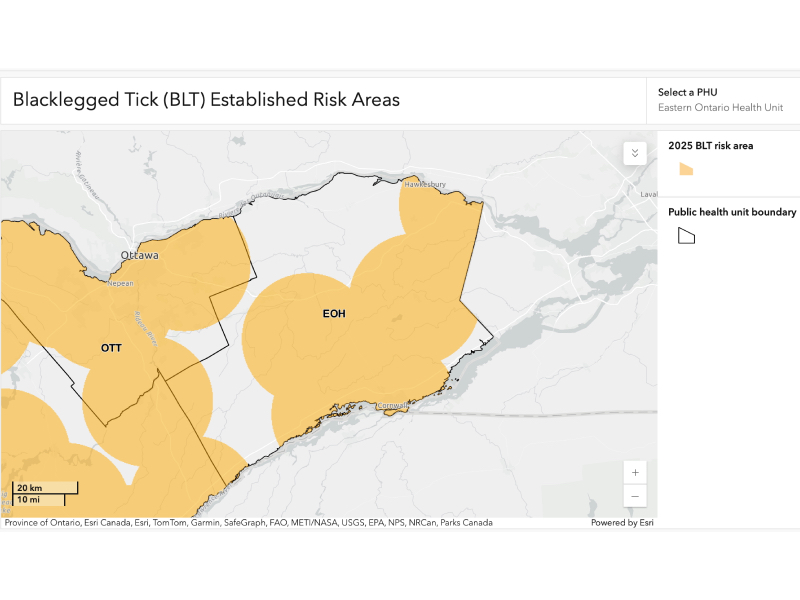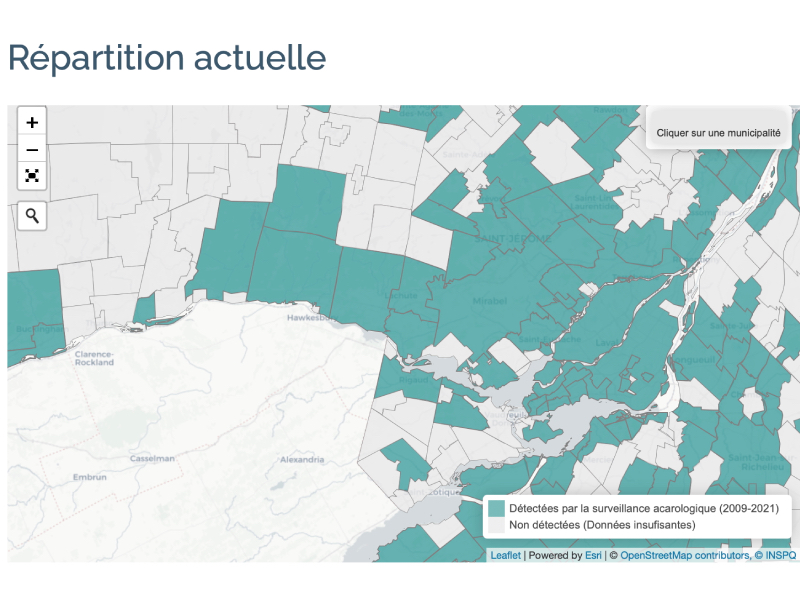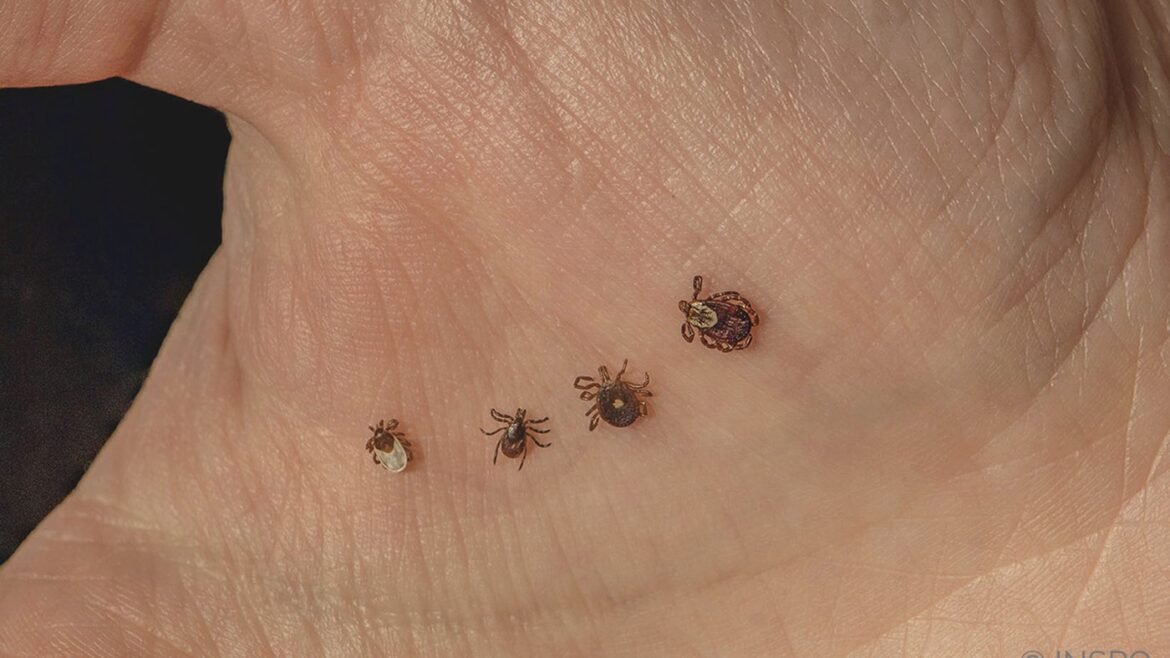By Philip Oddi | Vankleek Hill Review
Early summer is peak tick season in Eastern Ontario and Western Québec. Numerous agencies continue to remind citizens that ticks can carry and transmit Lyme disease, and that proper protective measures should be taken to prevent infection. Public Health Ontario (PHO) defines Lyme disease as an infection transmitted through the bite of an infected Blacklegged tick.
There are more than 40 species of established ticks in Canada, though not all carry disease or illnesses. The Public Health Agency of Canada (PHAC) states that the Blacklegged tick population is on the rise in Ontario and Québec.
The Québec Ministry of Health (QMH) reported an 11.27 per cent rise in reported cases of Lyme disease between 2022 and 2023, rising from 586 to 652. PHO reported that Ontario cases had increased by 23.02 per cent in the same period, from 1,516 to 1,865.

Health Canada explained that ticks can be active at any time when the weather is consistently above freezing, with no snow covering the ground. Additionally, because of climate change, ticks have begun to spread deeper into both provinces and have impacted areas not previously known to harbour large tick populations.
Ticks are predominantly found in heavily forested areas, shrubs, long grasses, leaves, and wood piles. They tend to bite areas such as inside or around the ears, behind the knees, lower back, and on the scalp of both humans and animals.



Identifying Ticks
Identifying ticks has become one of the main cornerstones in battling the spread of tick-borne illnesses in Canada. Ticks range in size, typically from the size of a poppy seed to a small grape when feeding.
To help with the challenge of identification, eTick.ca provides both an online and a mobile phone identifier application to aid in tracking the spread of ticks. The TickTool can help educate, identify, and track tick movement and potential exposure to tick-borne diseases.

The QMH has identified 12 species of ticks in Québec, and since 2003, Lyme disease has been a notifiable disease. According to the Ontario Ministry of Health (OMH), the disease has been a notifiable disease in the province since 1998. This means that all cases of Lyme disease must be reported to the local public health agency.
Tick protection and removal
Both PHO and the QMH explained that the chance of contracting Lyme disease from a tick bite is significantly lower if removed properly within 24 hours of being bitten.
To make ticks easier to spot, the QMH recommends wearing long and light-coloured clothing and closed shoes. Always tuck pants into socks and shirts into pants to limit skin exposure. Individuals should then check the common places where ticks bite on pets and themselves, and bathe or shower within two hours after returning.
Additionally, using insect repellent with DEET or icaridin can help prevent exposure to ticks carrying illnesses.
For pets, the QMH suggests speaking with a veterinarian about preventative medications, brushing your pet after outdoor walks, and when walking on trails, remaining as close to the centre as possible.
To prevent tick habitats in residential yards and commercial properties, lawns should be regularly mowed, bushes trimmed, and debris removed.
If a tick is found latched onto a human or pet, safe and proper removal is key to preventing potential infections.
To remove a tick from skin, the QMH and other health agencies recommend using fine tweezers and avoid using fingernails or fingers. There are four main steps to ensure proper tick removal:
Grasp the tick as close to the skin as possible; do not squeeze the tick’s abdomen
Pull gently and firmly without twisting or crushing the tick, straight up and away from the skin (if the tick’s head remains embedded into the skin, remove it with tweezers)
Keep the tick in an airtight container and refrigerate; note the date and time of the tick bite and when removed—this will help medical or veterinary professionals if consultation is needed
Clean the skin area with soap and warm water thoroughly
Symptoms and Treatment for Lyme disease
According to the QMH, symptoms of Lyme disease can range from person to person, but some of the more common symptoms include a skin rash that is usually not painful or itchy. The rash develops in approximately 60-80 per cent of Lyme disease cases, persists for more than 48 hours, and rapidly expands until over five centimetres in diameter.
Symptoms may appear days, weeks, or even months after the bite.
If the disease is not detected and allowed to spread through the blood, several expanding rashes may be possible, with more serious symptoms arising, such as facial paralysis, severe headaches, numbness in a limb, neck pain, or painless swelling in one or more joints. In some cases, chest pain, heart palpitations, and dizziness may occur.
Lyme disease cannot be transmitted from person to person or from animal to person.
The QMH strongly recommends contacting Info-Santé by dialling 811 or visiting a medical professional if individuals suspect infection.
For Ontario residents who suspect Lyme disease infection, the OMH recommends contacting the local public health unit or visiting a medical professional for further testing and guidance.
Treatment for Lyme disease normally includes prescribed antibiotics, and those infected often recover quickly and fully. The impact of antibiotics and treatment options depends on the stage of infection and corresponding symptoms.
According to the OMH, in some more severe cases, symptoms can last for years after the original infection. These can include recurring arthritis, neurological problems, paralysis, and in very rare cases, death.








